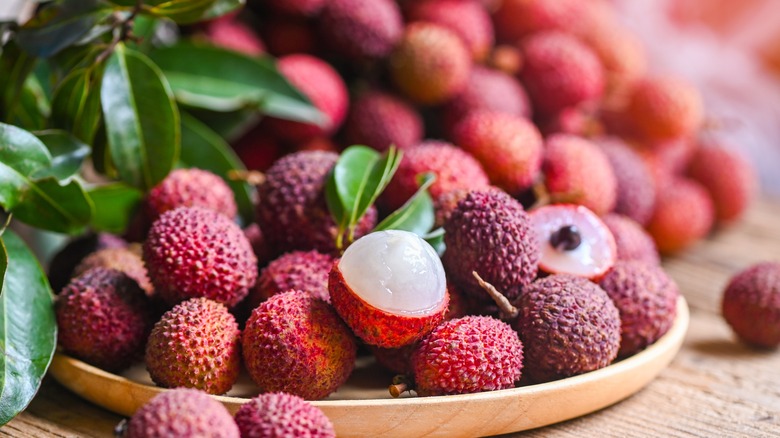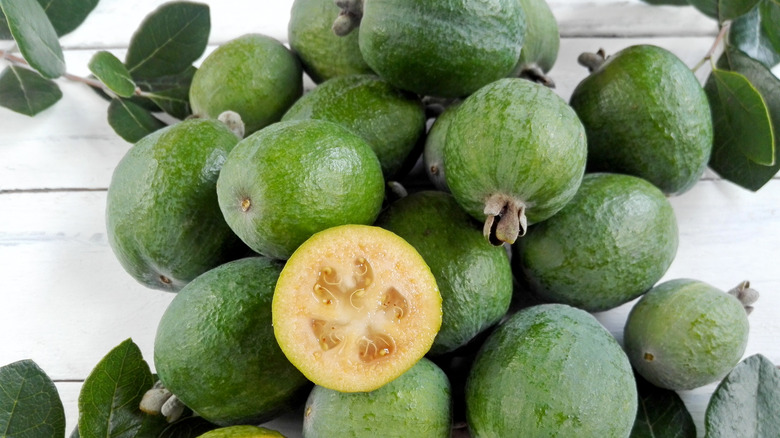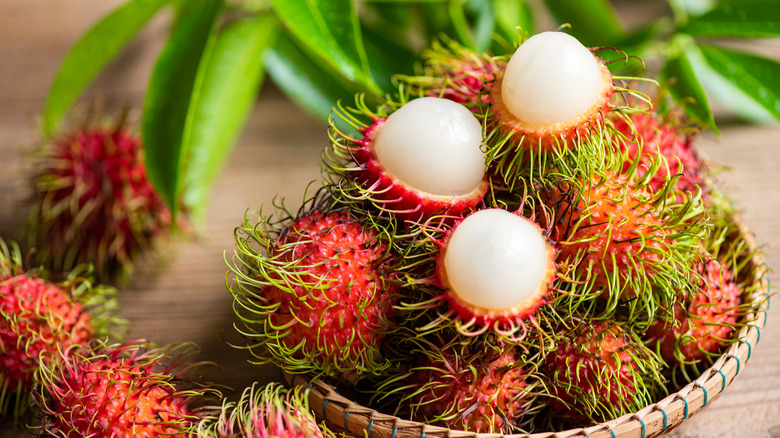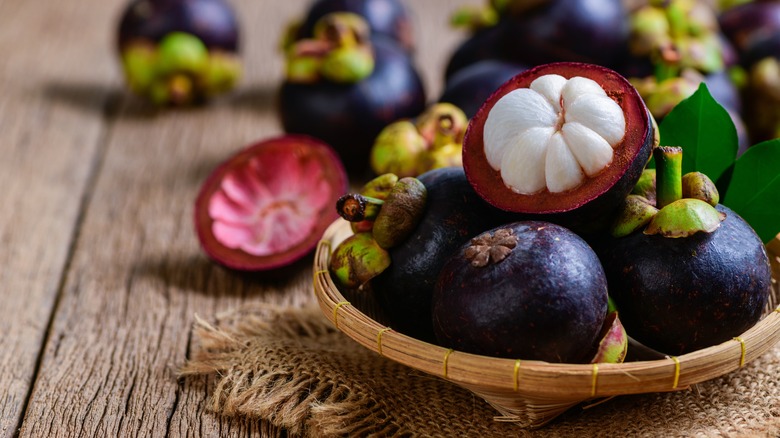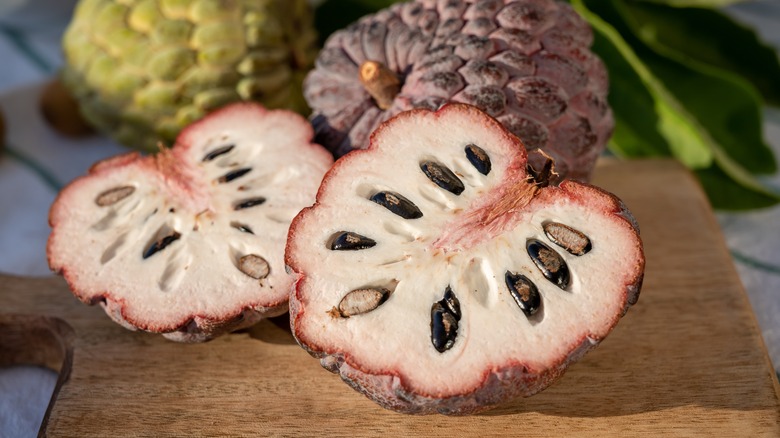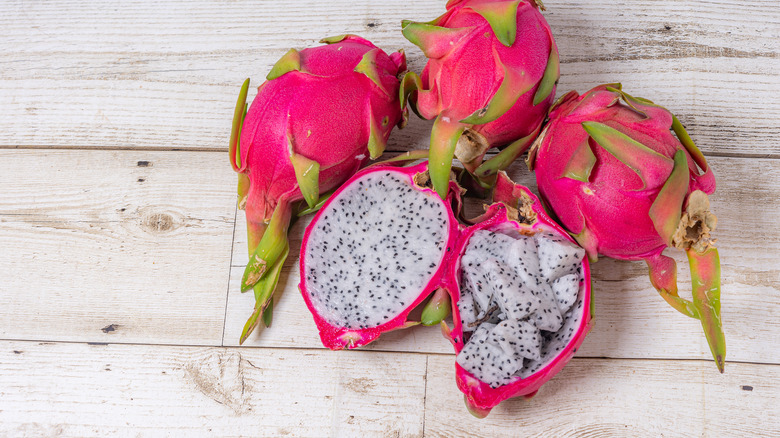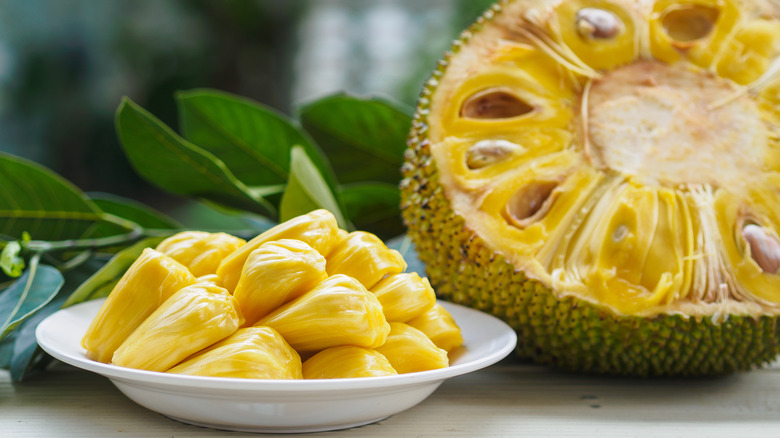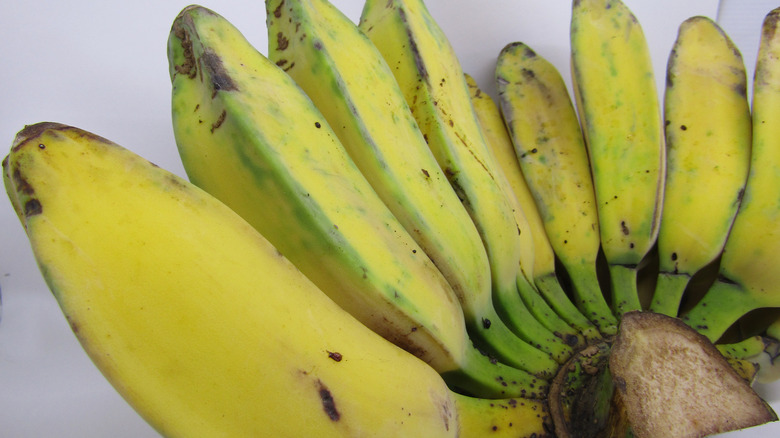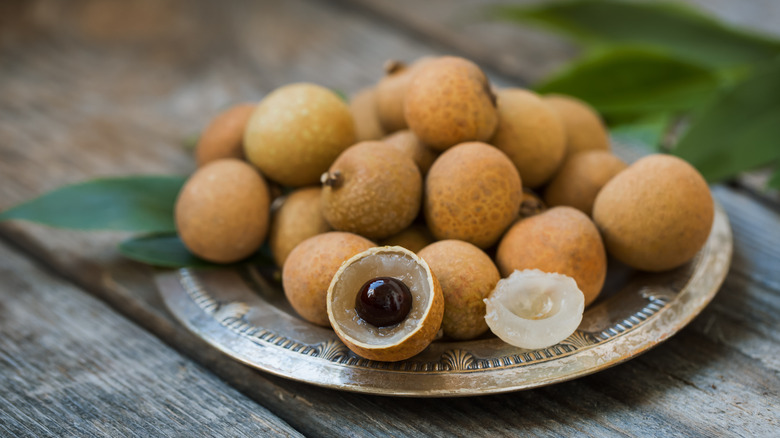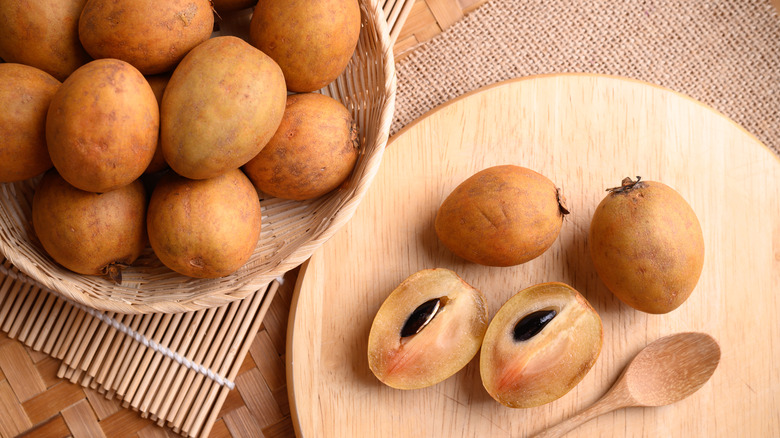14 Fruits Uncommon In The U.S. You Need To Try Once
If you've fallen into a routine of grabbing your favorite fruits from the grocery store and ignoring that carousel of exotic fruits that seems to go untouched in the center of the produce section, you're not alone. Bananas, strawberries, grapes, apples, and oranges have claimed the spotlight for most Americans, while some of the lesser-known varieties collect dust. There are thousands of species of fruits, many of which you may have never even heard of, all having unique shapes, colors, flavors, and textures. But why go out on a limb and spend $4 on some spiky pink fruit when you don't even know what it's going to taste like? That's why we are here to break down some of the top fruits that are uncommon in the U.S. that you need to try at least once.
The flavors of these foreign fruits can be quite incredible. It would be a shame to miss out on such a unique treat just because you're either unaware of their existence or intimidated by their appearance. If you are an experimental eater or just want to experience a little tropical vacation in your mouth, try purchasing one new-to-you fruit a month to try. Better yet, when you're actually on vacation, seek out these incredible fruits that you need to experience at least once.
Lychee
These little spiky red balls called lychee are natively grown in Asia, but have slowly made their way around the world and now grow in America. Although they are still quite uncommon to find in your average grocery store, you may be able to seek them out at an Asian market, find them in the specialty foods section, or even occasionally spot them at Trader Joe's. Before you buy, there is plenty you need to know about lychee fruit so you can determine if they are worth the purchase. They grow near the equator and have a hard exterior that needs to be removed in order to reach the white, rubbery fruit inside.
Once you've removed the outer peel, be cautious about biting right into the fruit. In the center of that sweet, scotch-white flesh is a pit that either needs to be removed or can be chewed around and spit out. Often, lychee is served at Asian restaurants in desserts or drinks. They are incredibly sweet and taste like a blend of watermelon and strawberry. Lychee has a slightly floral flavor and a very smooth finish.
Kiwano
Kiwano fruit, also known as African cucumber or horned melon, is quite distinctive in appearance with a spiky yellow exterior that looks almost extra-terrestrial. These fruits are common in Africa and have only recently made their way into the Western market.
They have a very refreshing flavor with a subtle sweetness and can be described as a mix between a cucumber and a banana. However, they do have a slight bitterness to them that gives them an extra punch. Once sliced open, the insides look like a cross between a kiwi and a cucumber, with large soft seeds and a tropical green hue. While in America we most commonly scrape out the green inside and only consume the pulp, traditionally the whole fruit is consumed, peel and all, and is cooked alongside vegetables.
Surprisingly enough, these fruits can sometimes be found at chain grocery stores in the United States or even ordered online. If you haven't noticed them up until this point, or have been avoiding them because you didn't know what they were, they are well worth the purchase when it comes to testing out unique fruits.
Feijoa
While you may have never even heard of a feijoa, it was actually brought to California in the late 1800s from its region of origin, South America. It's also called the pineapple guava or guavasteen because of its close relation to guava fruit, which you may have tried before either in fruit or juice form. Although the feijoa fruit itself is simple in appearance with a dark green smooth exterior and light green or yellow interior, its flower is a head turner botanically speaking. Its petals are light pink, white, and crimson red, with beautifully long and sturdy filament taking on a similar appearance to the hibiscus flower.
When sliced open, feijoa almost looks like a cross-section of a cucumber gone bad. They are sweet like pineapple and can be eaten by scooping out the interior with a spoon, similar to kiwi fruit. While they are most popularly eaten fresh, feijoa can be made into preserves and enjoyed on toast or yogurt for breakfast. If you're lucky to get your hands on one of these bad boys, don't pass up the opportunity to give it a try.
Rambutan
We've dabbled in some pretty bizarre-looking fruits, but rambutan takes the cake when it comes to alien-like features. These little spiky red balls look like strawberries that have sprouted seeds because protruding from the fruit are long bristle or hair-like extensions that can only be categorized as a cross between spiky and fuzzy. When harvested, those little hairs are green, but they often turn brown by the time they reach the market, especially if you're purchasing them in the U.S. because the fruit is native to Southeast Asia. Believe us, you'll want to see a photo of a rambutan fruit for yourself.
We don't have to tell you twice, but it's important to remove that spikey exterior before indulging in this mild, sweet fruit. Simply peel or cut it off, and then remove the large seed in the center of the white flesh. Rambutan tastes very similar to lychee and has a close resemblance in texture as well. This is because both fruits are members of the soapberry family and are closely related. Although they may be difficult to track down on the mainland in the U.S., you may be lucky enough to run into a market that carries them. Otherwise, seek them out during travel to tropical locations.
Mangosteen
Mangosteen, also referred to as the "queen of fruits," is highly desirable, quite expensive, and difficult to get your hands on, so if you've never heard of it, you're not alone. The real reason mangosteen is so expensive and unattainable is that its plant is temperamental and can only grow in very particle climates. In addition, the tree only produces fruit after years of maturing, and then only produces a viable crop every two to three years. Although expensive, this fruit makes the top of our list of uncommon fruits you need to try once — after all, you deserve the royal treatment.
With the appearance of a cross between a small purple pomegranate and a chestnut on the outside, this small fruit has a sweet and sour flavor. The inside is white and sectioned out like citrus fruit and is quite juicy. Its flavor bares a resemblance of a mix of lychee, pineapple, and strawberry with subtle sweet peach undertones. Although these little delicacies are best eaten raw, they can be incorporated into desserts or even savory protein dishes. If you can't get your hands on the fresh fruit, which will likely be the case, you can purchase them in canned or dried form, although it doesn't pack quite the same punch.
Cherimoya
Known as the ice cream fruit, cherimoya is one of those fruits you may have only heard of if you live near the southern border of California or frequent South America. Although its appearance may be slightly offputting, as it resembles a smooth artichoke because of its green scaly exterior, it's actually quite sweet, soft, and delicious. To enjoy a cherimoya, simply slice it in half from stem to base, and use a spoon to scoop out the soft white interior. Avoid the large black seeds, as they are not edible and actually can be quite toxic when chewed.
You should be eating more cherimoya because its flesh tastes like a combination of many tropical fruits including banana, papaya, pineapple, peach, and strawberry. Some people even report that it has a slight bubble gum flavor. It's known as the ice cream fruit because of its incredibly soft flesh and intense sweetness but is leagues healthier than the frozen dairy product. Look for the dessert fruit next time you're on the southern West Coast or in Hawaii, or try your luck in the exotic produce section of a fancy market. If you live in the Northeast, it's likely you may never get your hands on one of these sweet fruits unless you're willing to travel.
Loquat
If you enjoy peaches, apricots, and cherries, you will fully appreciate the sweet flavor of loquats which encompasses notes from each. If you've never heard of the fruit, it's likely because the tree is native to Asia and grows in the subtropics. The fruit is beautiful — bright orange — and looks quite a bit like a pear-shaped smooth peach or apricot. When split open, it contains four large seeds that are clustered in the center and surrounded by soft orange flesh. But that's not the only part of the plant people enjoy harvesting and ingesting. The leaves are commonly made into a tea that's traditionally produced and enjoyed in Japan.
Although the fruit is often enjoyed raw, loquat makes an incredible compote and can be used in baked goods and smoothies just like peaches. Wait to enjoy the loquat until it turns from green to yellow to bright orange. Loquat is hard to track down in the U.S., but some southern states import and feature the fruit in grocery stores, although they are a rare find. If you do get your hands on the sweet fruit, note that while the skin is edible, most people enjoy it peeled or cut in half with the flesh scooped out. This is because the skin is fuzzy and rather tangy.
Durian
This Southeast Asian fruit is perhaps one of the most menacing in the appearance of the lot. It's armored with impossibly thick, tough spikes that almost resemble spiky alligator skin. If you've ever seen jackfruit, the two look shockingly similar, but durian is by far more difficult to work with. The fruit is hard to open, and even dangerous to handle requiring multiple tools and hand protection to get the job done. But for those who have tried it, the challenge is well worth it in the end to get even just a bite of that fleshy, sweet fruit that encases each seed. The flavor has been described as sweet and the texture is custard-like.
There are many types of durian, and many interpretations of the smells they omit once cracked open. While some people find the scent to be sweet, satisfying, and beautifully fragrant, others find it comparable to sweaty gym clothes or rotting meat. All can agree that the smell, whether pleasant or grotesque, lingers. For this reason, the fruit has been banned in some public areas around Asia.
Pitaya
This eye-catching fruit is perhaps the most beautiful on the list. Also called dragon fruit, the fruit appears to be encased by bright pink petals or scales with green tips that have an almost mystical appearance. Once sliced open, the inside contains soft, white flesh speckled with little black seeds. Related to prickly pear, dragon fruit grows on cacti and is stunning in appearance, and has a sweet, mild, and almost floral flavor that has been described as a mix between pear and kiwi.
To enjoy this fruit, simply allow it to fully ripen (otherwise it's nearly flavorless), cut it open with a sharp knife, and scoop out the speckled white interior. Use a melon baller or spoon, and rest easy knowing that the seeds are small and edible. Because pitaya grows on cacti, they generally thrive in warm and dry climates, which is why you won't often see them in the United States. However, California, Florida, and Hawaii all grow the fruit commercially, so it's likely that pitaya may be hiding somewhere in your exotic produce section or even the freezer aisle.
Jackfruit
While jackfruit is one of those fruits that are uncommon in the United States, it's starting to make a name for itself as a meat replacer for vegans throughout Western culture. Jackfruit primarily grows in Asia, but producers in the U.S. have started cultivating the plant because of its steadily growing popularity. Resembling a durian, the fruit is green and spiky on the outside, although much easier to break apart. The fruits themselves are typically harvested around 10 to 20 pounds but can reach almost 100 pounds, so it's likely if your grocery store sells the fruit whole that you'd be aware.
When enjoyed ripe, the fruit tastes similar to pineapple and banana and is quite soft and sweet. However, it's likely that if you've had jackfruit, you've enjoyed it in its underdeveloped stage, which is more neutral in flavor and often acts as a vegan pulled pork substitute. There are plenty of fresh jackfruit vegan recipes, but typically it is shredded or peeled apart and doused with barbecue sauce before being roasted and pilled on buns with coleslaw. If your grocery store carries it, you'll most likely find it in the canned section, or an international section. Products like pulled "pork" jackfruit or jackfruit burgers can be found near the tofu, or in the freezer section.
Starfruit
You may just have better luck finding starfruit in the exotic produce section of your grocery store than many of the other uncommon fruits in the U.S. that we've listed thus far. Star fruit gets its name because when sliced into cross sections, it looks just like a bright yellow star. The outside skin is rubbery, and the inside texture lands somewhere between an Asian pear and citrus fruit. In fact, the sweet and sour flavor of the fruit tastes like a combination of the two as well.
Starfruit is often used to embellish salads, drinks, and desserts because of its beautiful appearance. Starfruit can be eaten, skin and all, but be sure to remove the seeds before indulging. Originally grown in Asia, starfruit is now cultivated in the Americas, which has made it much more accessible to those living in the U.S. Thank goodness for it, because this is not a fruit you'll want to pass up.
Blue java banana
For those of you who have discovered the wonders of the type of ice cream you can make with just one ingredient, bananas, then you'll be pleased to hear that there is a species of banana that can get you even closer to tasting like the real thing. This colorful banana variety tastes just like ice cream and has a custard-like vanilla flavor. Although they are famous for their blue peel, that unique color only presents itself on underripe bananas and turns banana yellow once fully ripened. Blue java bananas are a hybrid fruit made from two South Asian varieties of bananas.
To make the most believable nice cream you've ever had, peel and freeze blue java bananas overnight or until firm. Then simply blend them in a food processor until they become the consistency of soft serve ice cream. Surprisingly, you won't need to add vanilla or any other flavoring to make this vegan ice cream sing. For those of us up north, it's unlikely you'll ever run into the ultra-sweet variety at the grocery store. If you live in Florida, you may come across them at a farmers market, but for most, you'll have to turn to the internet.
Longan fruit
Although longan fruit isn't the most beautiful pick of the bunch, it makes up for its drab appearance with flavor. This little fruit grows in clusters and has the appearance of grapes. Their outer layer is tough and has an Asian pear-like skin, and the inside looks like mini lychee with a dark seed. Because of this, they are sometimes referred to as dragon's eyes. In fact, the longan fruit is part of the lychee family but tastes more like a grape with musky undertones.
What you need to know about longan fruit is that it's typically grown in Asia, although the fruit was brought to Florida but didn't catch on with consumers. It wasn't until the Kohala variety was introduced that the fruit stuck and was able to be commercially distributed in the United States. Even if you live in the southern regions, you may note that you've never actually tried the fruit. That's because it's still not widely popular in America, but should be because of its succulent, sweet flavors. While the fruit is typically eaten raw, it can also be cooked into dessert recipes and made into wine.
Sapodilla
Sapodilla is an incredibly sweet fruit with a unique flavor profile that has been described as a combination between pear, brown sugar, and sweet potato. The fruit itself does resemble a pear, with a long thin seed, making it look almost like an elongated peach when sliced open. Sapodilla becomes wrinkly when ripe, and should only be consumed when it reaches this stage. For those living in southern states, you may have come across such fruit as it is native to Central and South America and is also popular in the Caribbean. It has made its way up into America, but has yet to become a popular pick at the grocery store.
Sapodilla is incredibly sweet and can be eaten only when ripe, cooked into desserts, and even made into juice or alcoholic beverages. If you plan on eating the fruit raw, be sure to remove the sharp seeds that could be potentially very dangerous.

